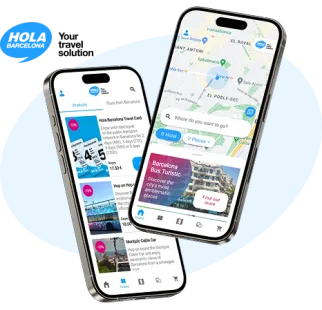Torre de Calatrava
A landmark of Barcelona's skyline
The Montjuïc communications tower, built by architect Santiago Calatrava for the Barcelona '92 Olympic Games, is part of the so-called Olympic Ring and is a must-see for fans of modern architecture. Its enormous white and curved silhouette, resembling an athlete holding the Olympic torch, has become an integral part of Barcelona’s urban landscape.

Montjuïc Cable Car, on the Hola Barcelona app
Your app for discovering the city from the heights with the Montjuïc Cable Car: journey, stops and most iconic places. A comfortable way to carry your tickets too!
A giant sundial
Built between 1989 and 1992, this 136-meter-high communications tower is made of steel and flexible concrete.
Due to its shape, the tower is designed to function as a sundial, with the shadow of its central spire projecting onto the adjacent Plaza de Europa.
The base of the Torre Calatrava is covered with trencadís, in a clear tribute to modernist architect Antoni Gaudí. However, unlike Gaudí’s vibrant color palette, Calatrava chose pure white for this mosaic decoration.
Once at Torre Calatrava, it is worth completing the visit to the Olympic Ring with the Estadi Olímpic Lluís Companys, the Palau Sant Jordi, and the Bernat Picornell swimming pools—essential landmarks of Olympic Barcelona.
For the curious of you
- Torre Calatrava is also known as Torre Telefónica, as it was the telecommunications company that covered the construction costs.






